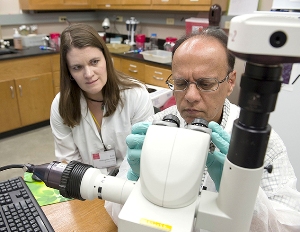Jul 18 2013
Nearly a dozen commercial and industrial scientists – some representing Fortune 500 companies and all possessing advanced degrees – arrived at Montana State University on Monday looking to go back to school for a day.
 Maya Singh, a microbiologist working with the medical device company CareFusion in Skokie, Ill., tries out a stereoscopic microscope at the Center for Biofilm Engineering on the Montana State University campus Monday, July 15, 2013 as research assistant Kelli Buckingham-Meyer looks on. MSU photo by Kelly Gorham.
Maya Singh, a microbiologist working with the medical device company CareFusion in Skokie, Ill., tries out a stereoscopic microscope at the Center for Biofilm Engineering on the Montana State University campus Monday, July 15, 2013 as research assistant Kelli Buckingham-Meyer looks on. MSU photo by Kelly Gorham.
The group came to learn what advanced microscope imaging can do to improve how, for instance, Church & Dwight Co., Inc., tests the ability of its Arm & Hammer products to kill or remove bacteria.
Their classroom for the day was MSU’s Center for Biofilm Engineering, a major exporter of scientific knowledge and technology on how to grow, test, eliminate or employ microbes in a variety of practical settings, from testing commercial products, to cleaning industrial infrastructure, to aiding in the production of biofuels. CBE’s research on these fronts is partially funded by 35 corporate members.
“A big part of the reason CBE is still going strong after 23 years is the support we get from industry,” said Phil Stewart, director of CBE. “The microscopy workshop and the interaction that will follow this week at the Montana Biofilm Science & Technology Meeting showcase our remarkable engagement with diverse, real-world concerns from healthcare to energy.”
What industrial partners get from the CBE comes in the form of often-groundbreaking science that supports their own research and development efforts. Last year CBE conducted 56 research projects for 34 industrial sponsors.
“That is a major technology transfer success story for MSU,” Stewart said. “Many of the projects involve microscopy because images are a very powerful way to understand and communicate what is happening in otherwise nearly invisible microbial communities.”
Gazing through high-powered, low-powered and 3-D microscopes under the direction of Betsey Pitts, CBE research associate and microscope facilities manager, the scientists watched as dyes reacted with fluorescent light to illuminate bacterial cells and the typically invisible and mysterious organic matrix that holds them in place. In one application, cells glowed green, while the connecting matrix glimmered red.
“This is awesome,” said Rehana Begum-Gafur, a scientist with the Colgate-Palmolive Company. Begum-Gafur said she was learning for the first time about the biofilm technology CBE has pioneered. “It’s really quite eye opening.”
The workshops CBE runs for its corporate partners prior to each semiannual meeting are aimed at giving industry scientists some practical application or methodology that they can use in their own labs. The microscopy workshop was particularly hands-on, complete with Pitts handing off a tip on how double-sided tape is good for both extracting biofilm from fabric and for holding it place in the liquid medium used for microscopic examination.
“The cool thing about this workshop is that it’s not a PowerPoint slide show,” Pitts said. “We know these people and their needs well enough that we want them to have the whole experience. And they want to learn the functional science that they can use to see if their treatment (of a biofilm) is working.”
In a full day of sessions that carried a conversational, question-and-answer feel, 11 scientists were shown how to stain a biofilm and operate a microscope themselves, photograph their sample and work through quantitative image analysis to judge the effect of a given agent on the biofilm.
Maya Singh, a scientist with the Chicago-based medical device company CareFusion, said he liked what he learned at the CBE and will be applying it to a new microbiology lab for the company.
“For a company like (CareFusion), understanding biofilm is very important for almost all our products,” Singh said.
In addition to technology transfer, the workshop holds a direct educational benefit for the MSU students working in CBE’s labs, some of who are involved as instructors. On Monday three undergraduates helped in the labs and a graduate student taught the visitors to use image analysis software.
“Our company visitors benefit from our students’ practical experience in the lab and our students benefit from the experience of processing their knowledge deeply enough to become a teacher,” Stewart said.
CBE assistant research professor Darla Goeres said students also gain a greater understanding of how CBE’s science gets used in the real world.
Goeres said a scientist from Procter and Gamble had helped MSU students land internships at the multinational corporation. “That’s a great opportunity,” she said.
While the fact that Montana produces cutting-edge science, and students, in the realm of biofilm is no surprise to industry, it is often surprising to the average person, said Paul Sturman, who coordinates the corporate membership program at CBE.
“Montana is known for the outdoors and Yellowstone,” Sturman said. “But we’re also known for top-notch science and it shows when Fortune 500 companies come from all over the world to see what we’re doing.”
Contact: Kristen Griffin, (406) 994-4743 or [email protected].